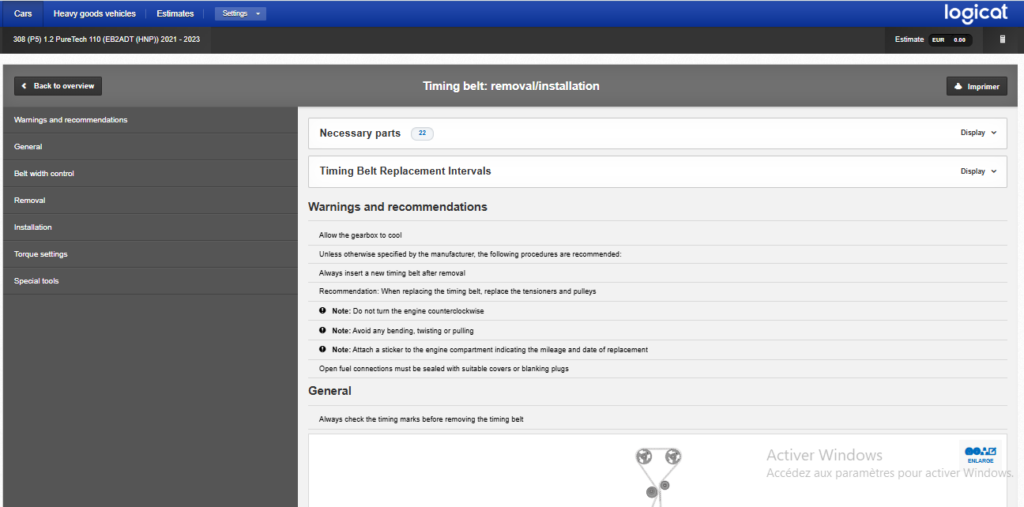
When to Replace the Timing Belt? Signs to Watch for to Avoid Serious Breakdowns
The timing belt is an essential component for the proper functioning of your vehicle’s engine. If it breaks or deteriorates, it can lead to costly and difficult-to-repair engine failures.
Table of Contents
Unusual Engine Noises: A Sign of Timing Belt Wear
Symptom:
If you hear squeaking or clicking noises coming from the engine, especially at startup or during acceleration, the timing belt may be worn or improperly tensioned.
Possible Causes:
Worn Timing Belt: Over time, the timing belt can deteriorate. These noises may indicate that the belt is losing its effectiveness.
Problems with Tensioners or Pulleys: If these components are faulty, they can also be responsible for unusual noises.
How HaynesPro Helps:
HaynesPro provides a comprehensive database and precise instructions to diagnose timing belt issues and their associated components. With its detailed guides, mechanics can quickly identify whether the timing belt is the source of the problem and proceed with the proper replacement.
Engine Overheating: An Indicator of a Faulty Timing Belt
Symptom:
If your engine frequently overheats and the temperature warning light comes on, this could be due to a faulty timing belt.
Possible Causes:
- Timing Issues: The timing belt ensures synchronization of several engine components, including the water pump. If it is defective, the water pump may not function correctly, causing the engine to overheat.
- Coolant Leaks: A worn timing belt can also cause leaks in the cooling system, disrupting the engine’s functioning.
How HaynesPro Helps:
With HaynesPro, mechanics can refer to technical sheets to check the timing belt, water pump, and other associated components. The diagnostic tool helps confirm if the timing belt is responsible for overheating and carry out the necessary repairs.
Loss of Engine Performance and Power: Could a Faulty Timing Belt Be the Cause?
Symptom:
A loss of power or engine misfires can be signs of a timing belt failure. If the engine seems to lack power, it may be due to poor synchronization caused by a worn belt.
Possible Causes:
- Deterioration of the Timing Belt: If the timing belt is worn or improperly tensioned, it can alter the synchronization of engine components, resulting in performance loss.
- Engine Timing Issues: An improperly adjusted timing belt can also disrupt engine timing, affecting system efficiency.
How HaynesPro Helps:
With HaynesPro, mechanics can check the timing belt’s tension and timing using precise specifications for each vehicle model. If the belt is the cause of the problem, HaynesPro provides step-by-step instructions for replacing it and restoring engine performance.
Case Study: Solving a Timing Belt Issue on a Peugeot 308 with HaynesPro
Context:
An auto repair shop receives a Peugeot 308 with a loss of power and strange noises from the engine. After an initial examination, the mechanic suspects that the timing belt is worn.
Diagnosis:
Using an OBD-II diagnostic tool, the mechanic finds no specific error codes, but the symptoms of power loss and strange noises are evident. After consulting HaynesPro, he learns that the timing belt needs to be replaced every 150,000 km, and the vehicle has surpassed this threshold, prompting him to inspect the timing belt.

Repair:
After removing the old timing belt, the mechanic finds that it is indeed worn and has irregular tension. Thanks to HaynesPro’s detailed information, he installs a new timing belt and adjusts the tensioner according to the manufacturer’s specifications.
Final Test:
The engine now runs smoothly, with regular acceleration. The customer is satisfied with the repair, and the vehicle’s performance is restored to optimal levels.
Conclusion:
Thanks to HaynesPro, the mechanic was able to quickly identify the root cause of the problem and perform the necessary repair, preventing serious engine damage and allowing the customer to safely get back on the road.
Ready to Replace Your Vehicle’s Timing Belt?
Try HaynesPro today

